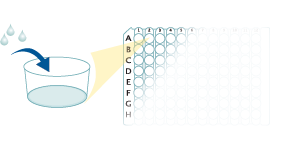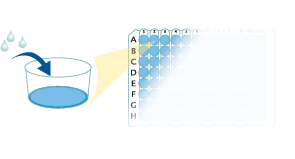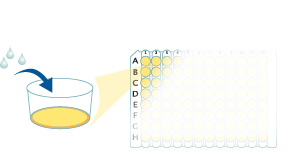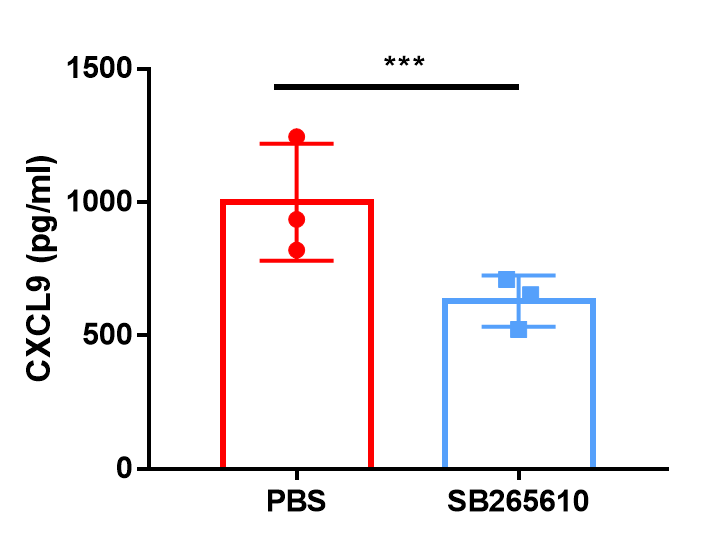Mouse CXCL9/MIG Quantikine ELISA Kit Summary
Product Summary
Precision
Cell Culture Supernates, Tissue Homogenates, Serum, EDTA Plasma
| Intra-Assay Precision | Inter-Assay Precision | |||||
|---|---|---|---|---|---|---|
| Sample | 1 | 2 | 3 | 1 | 2 | 3 |
| n | 20 | 20 | 20 | 23 | 23 | 23 |
| Mean (pg/mL) | 77 | 216 | 815 | 66 | 190 | 741 |
| Standard Deviation | 6.2 | 14.8 | 68 | 5.5 | 14.1 | 39.5 |
| CV% | 8.1 | 6.9 | 8.3 | 8.3 | 7.4 | 5.3 |
Recovery
The recovery of mouse MIG spiked to three levels throughout the range of the assay in various matrices was evaluated.
| Sample Type | Average % Recovery | Range % |
|---|---|---|
| Cell Culture Supernates (n=6) | 95 | 81-116 |
| EDTA Plasma (n=9) | 94 | 81-107 |
| Serum (n=9) | 93 | 85-112 |
| Tissue Homogenates (n=2) | 104 | 88-118 |
Linearity
Scientific Data
Product Datasheets
Preparation and Storage
Background: CXCL9/MIG
CXCL9, also known as MIG, is a chemokine that is induced in macrophages and in CNS glial cells in response to IFN-gamma. CXCL9 signals through CXCR3 to induce the chemoattraction of activated T cells and tumor-infiltrating lymphocytes.
Assay Procedure
Refer to the product- Prepare all reagents, standard dilutions, and samples as directed in the product insert.
- Remove excess microplate strips from the plate frame, return them to the foil pouch containing the desiccant pack, and reseal.
- Add 50 µL of Assay Diluent to each well.
- Add 50 µL of Standard, Control, or sample to each well. Cover with a plate sealer, and incubate at room temperature for 2 hours on a horizontal orbital microplate shaker.
- Aspirate each well and wash, repeating the process 4 times for a total of 5 washes.
- Add 100 µL of Conjugate to each well. Cover with a new plate sealer, and incubate at room temperature for 2 hours on the shaker.
- Aspirate and wash 5 times.
- Add 100 µL Substrate Solution to each well. Incubate at room temperature for 30 minutes on the benchtop. PROTECT FROM LIGHT.
- Add 100 µL of Stop Solution to each well. Read at 450 nm within 30 minutes. Set wavelength correction to 540 nm or 570 nm.





Citations for Mouse CXCL9/MIG Quantikine ELISA Kit
R&D Systems personnel manually curate a database that contains references using R&D Systems products. The data collected includes not only links to publications in PubMed, but also provides information about sample types, species, and experimental conditions.
28
Citations: Showing 1 - 10
Filter your results:
Filter by:
-
Epigallocatechin Gallate-Modified Silver Nanoparticles Show Antiviral Activity against Herpes Simplex Type 1 and 2
Authors: Krzyzowska, M;Janicka, M;Chodkowski, M;Patrycy, M;Obuch-Woszczaty?ska, O;Tomaszewska, E;Ranoszek-Soliwoda, K;Celichowski, G;Grobelny, J;
Viruses
Species: Mouse
Sample Types: Vaginal Lavage Fluid
-
LHPP-mediated inorganic pyrophosphate hydrolysis-driven lysosomal acidification in astrocytes regulates adult neurogenesis
Authors: Sha, L;Li, J;Shen, H;Wang, Q;Meng, P;Zhang, X;Deng, Y;Zhu, W;Xu, Q;
Cell reports
Species: Mouse
Sample Types: Cell Culture Supernates
-
Anti?VEGF antibody triggers the effect of anti?PD?L1 antibody in PD?L1low and immune desert?like mouse tumors
Authors: N Ishikura, M Sugimoto, K Yorozu, M Kurasawa, O Kondoh
Oncology reports, 2021-12-27;47(2):.
Species: Mouse
Sample Types: Tissue Homogenates
-
Metastasis-initiating cells induce and exploit a fibroblast niche to fuel malignant colonization of the lungs
Authors: M Pein, J Insua-Rodr, T Hongu, A Riedel, J Meier, L Wiedmann, K Decker, MAG Essers, HP Sinn, S Spaich, M Sütterlin, A Schneeweis, A Trumpp, T Oskarsson
Nat Commun, 2020-03-20;11(1):1494.
Species: Mouse
Sample Types: Tissue Lysate
-
Bradykinin 1 receptor blockade subdues systemic autoimmunity, renal inflammation, and blood pressure in murine lupus nephritis
Authors: L Qin, Y Du, H Ding, A Haque, J Hicks, C Pedroza, C Mohan
Arthritis Res. Ther., 2019-01-08;21(1):12.
Species: Mouse
Sample Types: Urine
-
Murine ?-Herpesvirus 68 Induces Severe Lung Inflammation in IL-27-Deficient Mice with Liver Dysfunction Preventable by Oral Neomycin
Authors: K Kanai, AM Park, A Watanabe, T Arikawa, T Yasui, H Yoshida, I Tsunoda, O Yoshie
J. Immunol., 2018-03-02;0(0):.
Species: Mouse
Sample Types: BALF
-
CXCR3/CXCL10 Axis Shapes Tissue Distribution of Memory Phenotype CD8+ T Cells in Nonimmunized Mice
Authors: C Alanio, R Barreira d, D Michonneau, P Bousso, MA Ingersoll, ML Albert
J. Immunol., 2017-11-29;0(0):.
Species: Mouse
Sample Types: Tissue Homogenates
-
CXCL9 compensates for the absence of CXCL10 during recurrent Herpetic stromal keratitis
Authors: D Tajfirouz, DM West, XT Yin, CA Potter, R Klein, PM Stuart
Virology, 2017-03-07;506(0):7-13.
Species: Mouse
Sample Types: Tissue Homogenates
-
CXCR3 Blockade Inhibits T Cell Migration into the Skin and Prevents Development of Alopecia Areata
J Immunol, 2016-07-13;0(0):.
Species: Mouse
Sample Types: Serum
-
CXCR3 promotes plaque formation and behavioral deficits in an Alzheimer's disease model.
Authors: Krauthausen M, Kummer M, Zimmermann J, Reyes-Irisarri E, Terwel D, Bulic B, Heneka M, Muller M
J Clin Invest, 2014-12-15;125(1):365-78.
Species: Mouse
Sample Types: Cell Culture Supernates
-
IL-15 complexes induce NK- and T-cell responses independent of type I IFN signaling during rhinovirus infection.
Authors: Jayaraman A, Jackson D, Message S, Pearson R, Aniscenko J, Caramori G, Mallia P, Papi A, Shamji B, Edwards M, Westwick J, Hansel T, Stanciu L, Johnston S, Bartlett N
Mucosal Immunol, 2014-01-29;7(5):1151-64.
Species: Mouse
Sample Types: Whole Cells
-
Cleavage of the T cell protein tyrosine phosphatase by the hepatitis C virus nonstructural 3/4A protease induces a Th1 to Th2 shift reversible by ribavirin therapy.
Authors: Brenndorfer E, Brass A, Karthe J, Ahlen G, Bode J, Sallberg M
J Immunol, 2014-01-17;192(4):1671-80.
Species: Mouse
Sample Types: Cell Lysates, Whole Cells
-
Interferon gamma-induced intratumoral expression of CXCL9 alters the local distribution of T cells following immunotherapy with
Authors: Guirnalda P, Wood L, Goenka R, Crespo J, Paterson Y
Oncoimmunology, 2013-07-23;2(8):e25752.
Species: Mouse
Sample Types: Tissue Homogenates
-
Modelling of mouse experimental colitis by global property screens: a holistic approach to assess drug effects in inflammatory bowel disease.
Authors: Gottfries J, Melgar S, Michaelsson E
PLoS ONE, 2012-01-18;7(1):e30005.
Species: Mouse
Sample Types: Tissue Homogenates
-
NKT cells mediate pulmonary inflammation and dysfunction in murine sickle cell disease through production of IFN-gamma and CXCR3 chemokines.
Authors: Wallace KL, Marshall MA, Ramos SI, Lannigan JA, Field JJ, Strieter RM, Linden J
Blood, 2009-05-11;114(3):667-76.
Species: Mouse
Sample Types: Tissue Homogenates
-
A novel mechanism for CCR4 in the regulation of macrophage activation in bleomycin-induced pulmonary fibrosis.
Authors: Trujillo G, O'Connor EC, Kunkel SL, Hogaboam CM
Am. J. Pathol., 2008-04-10;172(5):1209-21.
Species: Mouse
Sample Types: Tissue Homogenates
-
Chemokine receptor CXCR3 and its ligands CXCL9 and CXCL10 are required for the development of murine cerebral malaria.
Authors: Campanella GS, Tager AM, El Khoury JK, Thomas SY, Abrazinski TA, Manice LA, Colvin RA, Luster AD
Proc. Natl. Acad. Sci. U.S.A., 2008-03-17;105(12):4814-9.
Species: Mouse
Sample Types: Tissue Homogenates
-
The direct action of 1alpha,25(OH)2-vitamin D3 on purified mouse Langerhans cells.
Authors: Fujita H, Asahina A, Komine M, Tamaki K
Cell. Immunol., 2007-05-15;245(2):70-9.
Species: Mouse
Sample Types: Cell Culture Supernates
-
Therapeutic targeting of CC ligand 21 or CC chemokine receptor 7 abrogates pulmonary fibrosis induced by the adoptive transfer of human pulmonary fibroblasts to immunodeficient mice.
Authors: Pierce EM, Carpenter K, Jakubzick C, Kunkel SL, Flaherty KR, Martinez FJ, Hogaboam CM
Am. J. Pathol., 2007-04-01;170(4):1152-64.
Species: Mouse
Sample Types: Tissue Homogenates
-
TLR3 ligand stimulates fully functional memory CD8+ T cells in the absence of CD4+ T-cell help.
Authors: Hervas-Stubbs S, Olivier A, Boisgerault F, Thieblemont N, Leclerc C
Blood, 2007-03-05;109(12):5318-26.
Species: Mouse
Sample Types: Serum
-
Intact TRL 9 and type I interferon signaling pathways are required to augment HSV-1 induced corneal CXCL9 and CXCL10.
Authors: Wuest T, Austin BA, Uematsu S, Thapa M, Akira S, Carr DJ
J. Neuroimmunol., 2006-08-01;179(1):46-52.
Species: Mouse
Sample Types: Tissue Homogenates
-
Organ-specific role of MyD88 for gene regulation during polymicrobial peritonitis.
Authors: Weighardt H, Mages J, Jusek G, Kaiser-Moore S, Lang R, Holzmann B
Infect. Immun., 2006-06-01;74(6):3618-32.
Species: Mouse
Sample Types: Tissue Homogenates
-
Persistent effects induced by IL-13 in the lung.
Authors: Fulkerson PC, Fischetti CA, Hassman LM, Nikolaidis NM, Rothenberg ME
Am. J. Respir. Cell Mol. Biol., 2006-04-27;35(3):337-46.
Species: Mouse
Sample Types: BALF
-
CXCL10 is the key ligand for CXCR3 on CD8+ effector T cells involved in immune surveillance of the lymphocytic choriomeningitis virus-infected central nervous system.
Authors: Christensen JE, de Lemos C, Moos T, Christensen JP, Thomsen AR
J. Immunol., 2006-04-01;176(7):4235-43.
Species: Mouse
Sample Types: CSF
-
A distinct and unique transcriptional program expressed by tumor-associated macrophages (defective NF-kappaB and enhanced IRF-3/STAT1 activation).
Authors: Biswas SK, Gangi L, Paul S, Schioppa T, Saccani A, Sironi M, Bottazzi B, Doni A, Vincenzo B, Pasqualini F, Vago L, Nebuloni M, Mantovani A, Sica A
Blood, 2005-11-03;107(5):2112-22.
Species: Mouse
Sample Types: Cell Culture Supernates
-
The human herpes virus 8-encoded chemokine receptor is required for angioproliferation in a murine model of Kaposi's sarcoma.
Authors: Jensen KK, Manfra DJ, Grisotto MG, Martin AP, Vassileva G, Kelley K, Schwartz TW, Lira SA
J. Immunol., 2005-03-15;174(6):3686-94.
Species: Mouse
Sample Types: Tissue Homogenates
-
Suppression of graft coronary artery disease by a brief treatment with a selective epsilonPKC activator and a deltaPKC inhibitor in murine cardiac allografts.
Authors: Tanaka M, Terry RD, Mokhtari GK, Inagaki K, Koyanagi T, Kofidis T, Mochly-Rosen D, Robbins RC
Circulation, 2004-09-14;110(11):II194-9.
Species: Mouse
Sample Types: Tissue Homogenates
-
Cardiomyocyte-specific Bcl-2 overexpression attenuates ischemia-reperfusion injury, immune response during acute rejection, and graft coronary artery disease.
Authors: Tanaka M, Nakae S, Terry RD, Mokhtari GK, Gunawan F, Balsam LB, Kaneda H, Kofidis T, Tsao PS, Robbins RC
Blood, 2004-07-27;104(12):3789-96.
Species: Mouse
Sample Types: Tissue Homogenates
FAQs
-
Assay Diluent RD1-63 contains visible precipitate. Is this acceptable to use?
A small amount of precipitate is expected and acceptable in Assay Diluent RD1-63. Variability has been observed between vials and diluent lots. It may not fully resolubilize but this will not impact assay performance. It is not recommended to filter the precipitate.
Reviews for Mouse CXCL9/MIG Quantikine ELISA Kit
Average Rating: 5 (Based on 5 Reviews)
Have you used Mouse CXCL9/MIG Quantikine ELISA Kit?
Submit a review and receive an Amazon gift card.
$25/€18/£15/$25CAN/¥75 Yuan/¥2500 Yen for a review with an image
$10/€7/£6/$10 CAD/¥70 Yuan/¥1110 Yen for a review without an image
Filter by:
Produced results with expected direction according to mRNA and functional assays, reasonably easy to perform.









